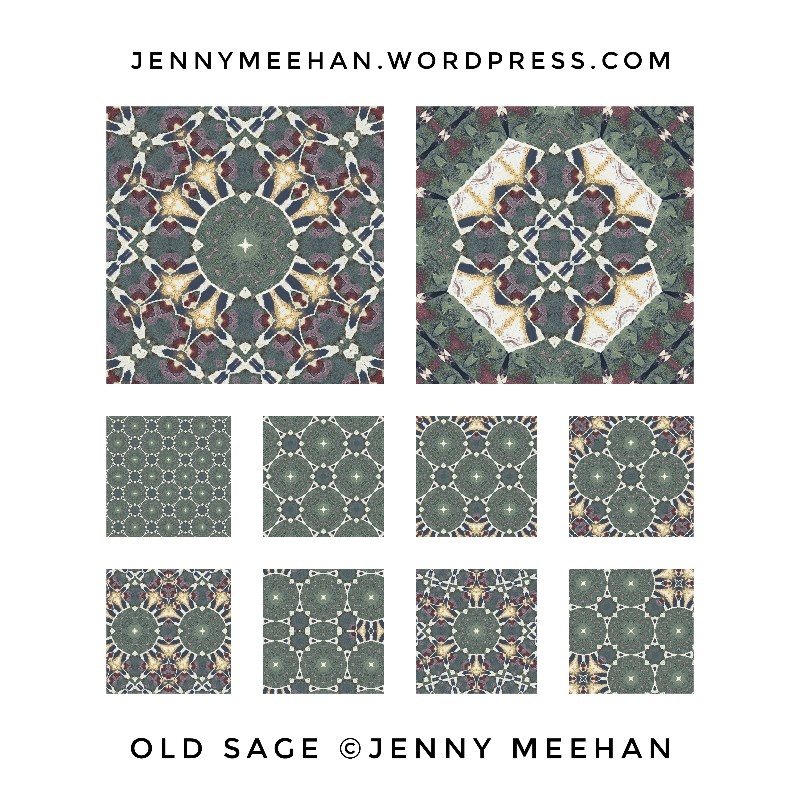February 2024!
To subscribe to this art journal, use the button above. To contact me follow link below: https://jennymeehan.wordpress.com/jenny-meehan-jennifer-meehan-how-to-contact-me/
All images, unless marked otherwise are ©jenny meehan
To start, a few paintings to view!
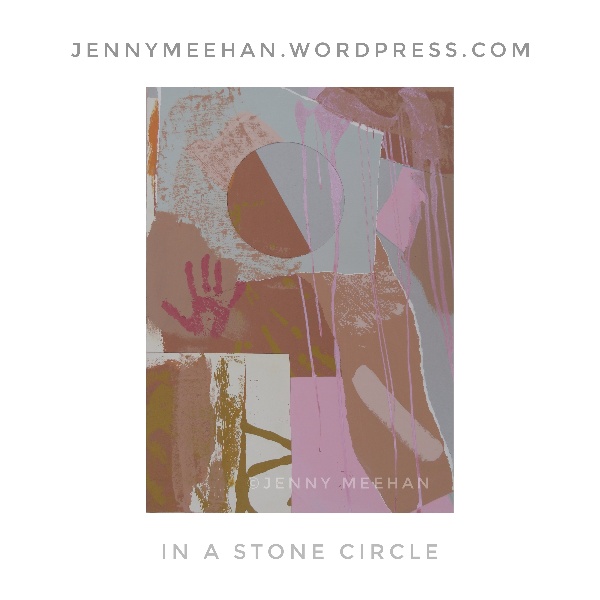
“In a Stone Circle” painting by jenny meehan ©jenny meehan
This painted collage is quite large, around A1 roughly. I now use greyboard a lot as a substrate because it’s economical and doesn’t use up too much space. I’ve gone off using oil paint and canvas. It’s for sale as an unsigned print here: https://www.redbubble.com/shop/ap/124734947?asc=u
The original painted collage is for sale Contact me using contact form if interested.
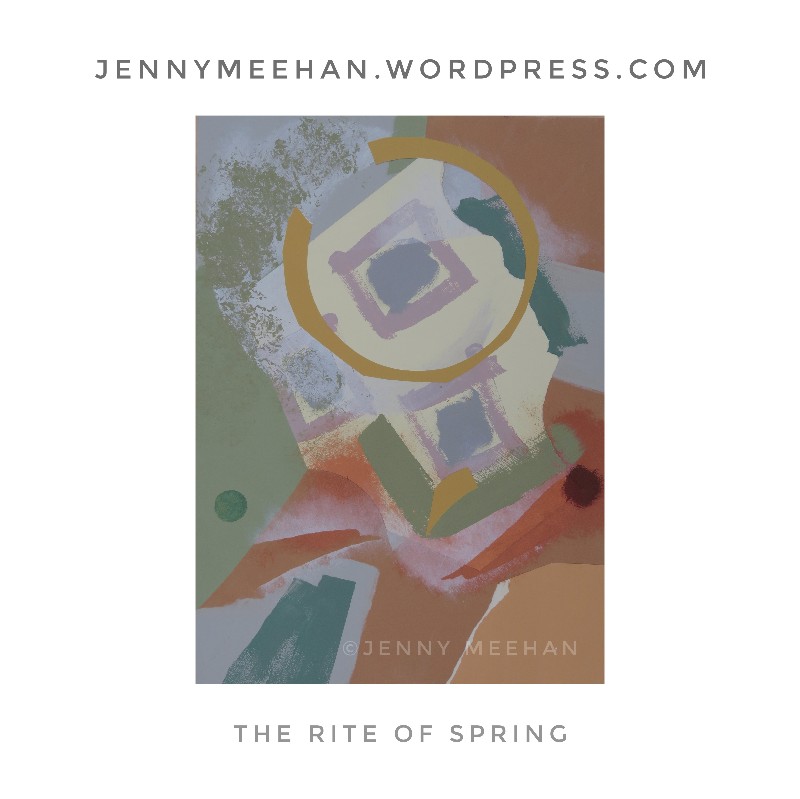
“The Rite of Spring” painting by jenny meehan ©jenny meehan
It’s the matt surface of the Keim Sol-Silicate paints along with its environmentally friendly features which has pushed me to the point of no return. Plus I use images of my painting a lot digitally and there are no unwanted reflections. It’s for sale as an unsigned print here: https://www.redbubble.com/shop/ap/124735597?asc=u
The original painted collage is for sale Contact me using contact form if interested.
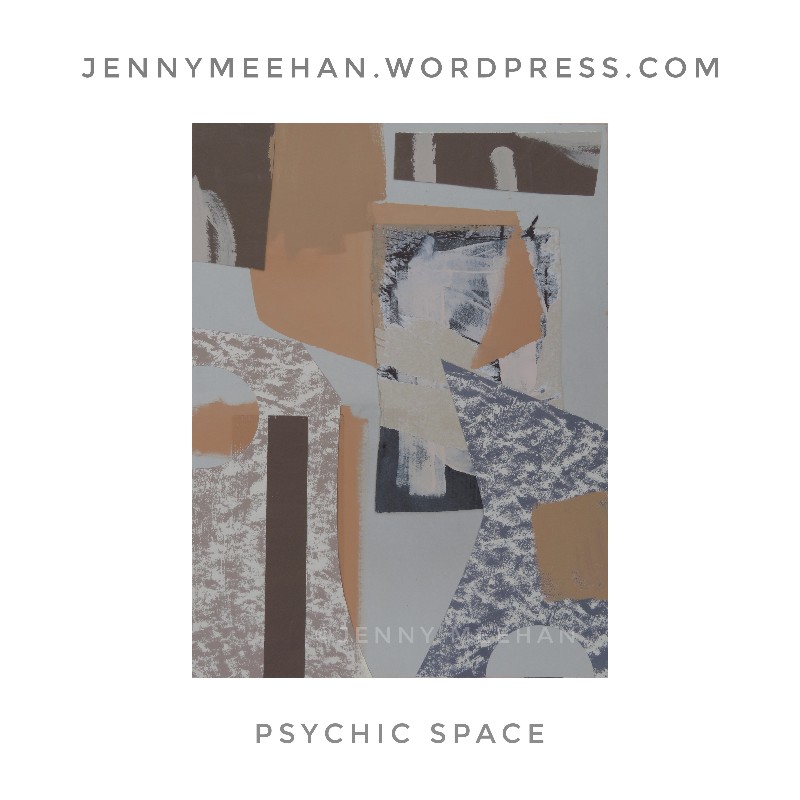
“Psychic Space” painting by jenny meehan ©jenny meehan
For me, “Psychic Space” is something I feel more aware of than I used to. The sense there is space, internal space, which is secure, liberating and in which I can experience a sense of being grounded. I guess this is to a large degree one of the benefits of having worked in tandem with a psychotherapist for so many years, along with a progressive Christian faith, prayer, meditation, contemplation and beautiful nature to help me. The images look a bit dull here, they are a lot brighter in that nice restrained way in the flesh. I’ve made a slightly brighter version for my redbubble artist profile.

“Spring Dance” painting by jenny meehan ©jenny meehan
Unfortunately the contrast between the white of a device screen and the image does it no favours! What this one does show is a strand of new developments in markmaking. I’ve become a fan of thick linear elements. It’s rather bold, I think I like the boldness. It’s a kind of liberation, not being delicate. Not that I ever have been particularly delicate.
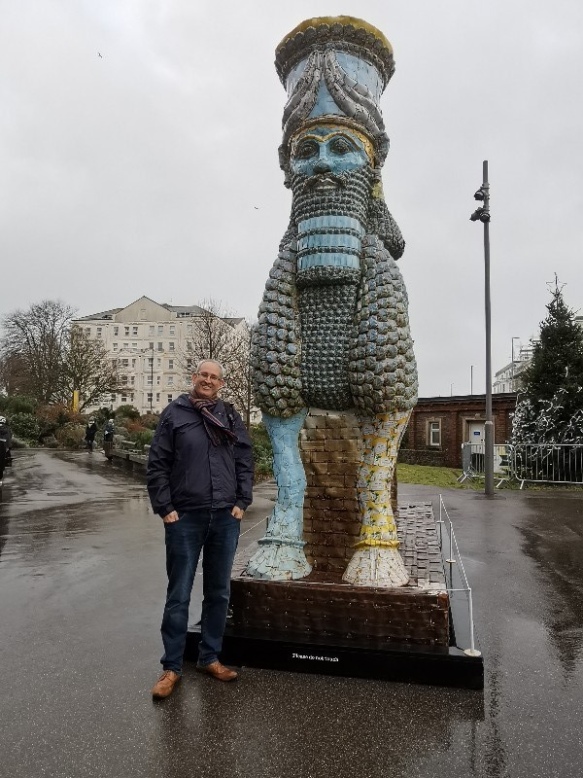 Neil Meehan my husband. We had a nice time in Eastbourne. This amazing work was a bonus. It’s by Michael Rakowitz “The invisible enemy should not exist” (Lamassu of Nineveh)
Neil Meehan my husband. We had a nice time in Eastbourne. This amazing work was a bonus. It’s by Michael Rakowitz “The invisible enemy should not exist” (Lamassu of Nineveh)
February Imbolc Meditation
Margaret Atwood Quote
“Water does not resist. Water flows. When you plunge your hand into it, all you feel is a caress. Water is not a solid wall, it will not stop you. But water always goes where it wants to go, and nothing in the end can stand against it. Water is patient. Dripping water wears away a stone. Remember that, my child. Remember you are half water. If you can’t go through an obstacle, go around it. Water does.”
Margaret Atwood, The Penelopiad
On the subject of water, I’m not Open Water Swimming this year yet, as I wait till around March before getting into the river again, though I may hop in the sea a few times before then.
Here Comes My Body
This video is a short expression of my experience of therapeutic yoga and other healing modalities such as psychoanalytic psychotherapy which have played and play a part in reconnection and recovery from dissociation, primarily due to rape trauma.
It shows a “Talkups” doll toy. The one shown is “Silly Talk”. TalkUp Dolls by Mattel were manufactured and sold in 1971. This one used the voice of JoAnne Worley.
I chose this item this because it includes both a talking voice and a body and head being pulled apart and then becoming connected again. I feel this shows very simply the tension of mind – body seperation yet also the body’s natural desire to reconnect and heal. Plus it has an element of humour, even though, in the context of its creation, this becomes rather dark.
It was not “Silly Talk” but serious talking, which brought me to a place of creating this! Talking therapies can be life savers for many people. This was the case with me.
It is also the case that I’ve been fortunate to work through a lot of childhood related distress, along with later traumatic effects resulting from two rapes and several sexual assaults. The psychological disorder which comes with these experiences can be worked through, though it is a lot of hard work. However, this process lessens the weight, and other results of early disconnections.
If you’d like to read a brief overview of the main circumstances which led me into investing myself into the personal work of psychoanalytic psychotherapy, look here: https://wp.me/prsao-1pf
It’s the part under Nigel Fountain’s Brief Encounter’s written for The Oldie Magazine.
(you will need to scroll down the post a bit)
This is relevant to “Here Comes My Body” because the the huge amount of work both myself and my therapist have needed to invest into my recovery journey in order to get to the place I am now. In an ideal world, I think every earthly judge and jury would benefit from a very comprehensive understanding and appreciation of how destructive rape actually is. Many people do valuable work in this area, but more needs to be done. As is the need in all areas of crime, of course, but crimes against humanity are more grievous than those concerning material wealth.
Anyway, back to my general direction!
What I fondly refer to “my obituary” written by Nigel Fountain for The Oldie Magazine, is something I’m very grateful for. I call it my obituary because it was a key event for me in respect to recognising, and accepting, the extent of the damage done to me, in particular, with relation the second rape, which was premeditated and involved me being drugged. The dissociation of that event was severe. I vividly recall, when I came to consciousness, looking down on my own body as I got up from the floor. Weird, I know, but sadly true. I blocked the whole thing out my consciousness mind for ten years… I couldn’t exist without denial.
When I created “Here Comes my Body” it was very much in acknowledgement of the extent of the damage done and the vast work of reconnection involved. I was drug raped 40 years ago! That’s a long time ago. It’s only now, I’m experiencing a level of connection with my physical body which resembles similar to what I had before I was raped. I say similar… I think it’s probably better actually, but I definitely have a kind of “recognition” going on, which means I feel connected to what I will call my “pre rape” body. And I’d lost that. That fundamental connection. It was stolen from me by a weak, narcissistic and totally arrogant sociopath, who was so inheritantly deceitful, that I’ve no doubt he thought his action non problematic and of little consequence. The extent to which a person’s conscience can be seared is indicative of how enslaved to evil they are.
So I tend to view Nigel Fountain’s article as a significant marker in my recovery, because my rather lengthy confessional of horrible life events, though delivered at a time when I was extremely fragile to a total stranger, turned out to be a marker in my journey of great significance. It was a point where, past and present, though completely disconnected through the fragmentation of self which comes from overwhelming trauma, meet for a moment and we realise how vulnerable us mortals are. I certainly did, and from the way he wrote about me, (which was deeply insightful), I think he did too. “Brief Encounters” was a series of articles Nigel Fountain wrote, but the one he wrote about me was published in The Oldie Magazine in June 2014.
I may be waxing lyrical a bit, I know, but I will anyway. Because to see what was “the death of me” in the sense of recognising and facing, those many circumstances and events of life which were damaging to me , and then to be able to reframe them, mainly, (though not exclusively) through therapy, and recover grounding lost, over time, is totally, a resurrected (way of) life.
I express this best in my own faith tradition and theology: the purposes of Godde in Christ are realised… This “Resurrection” and the power of divine compassionate love, are made incarnate and manifest through Godde’s grace working through and around me. This is my freedom and my deliverence from oppression of many kinds. An awareness of the Holy Spirit and a desire for the divine purposes of compassionate love.
And so, by the Thames, on that day of my “interview” with Nigel Fountain, I think I now choose to understand that fortunate meeting even as a kind of sacrament; A baptism of sorts. Why? Because the symbolism of baptism starts with death and ends with life. So having had my “obituary” written at that point is perfectly fitting for me! It was pretty similar to giving a testimony, as it happens…
In the Now
It’s wonderful to experience healthy bodily connection so deeply now, yet also shocking to see how destructive and damaging sexual violence is.
I’m grateful to our Creator for the Holy Spirit who inspires me to create. My spiritual, contemplative, and creative practices as a progressive christian inform all of my creative artworking.
New Redbubble Art Prints
Old Sage by Jenny Meehan aka jennyjimjams ©jenny meehan
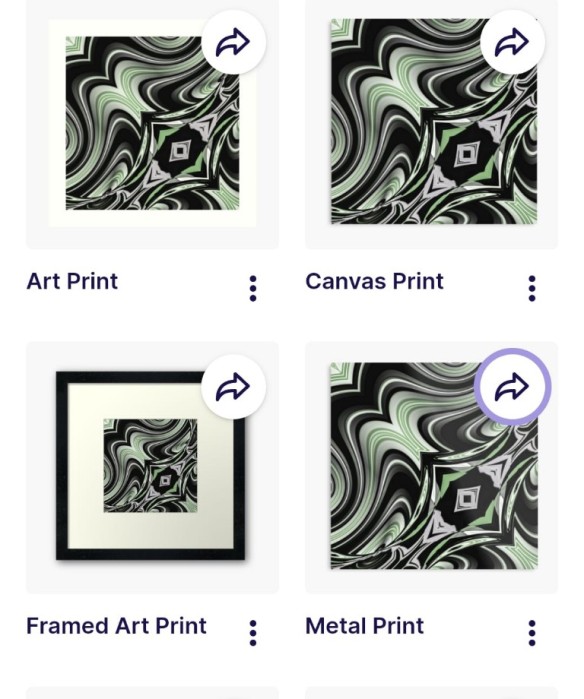
Plasticine Colour Play Abstract by Jenny Meehan
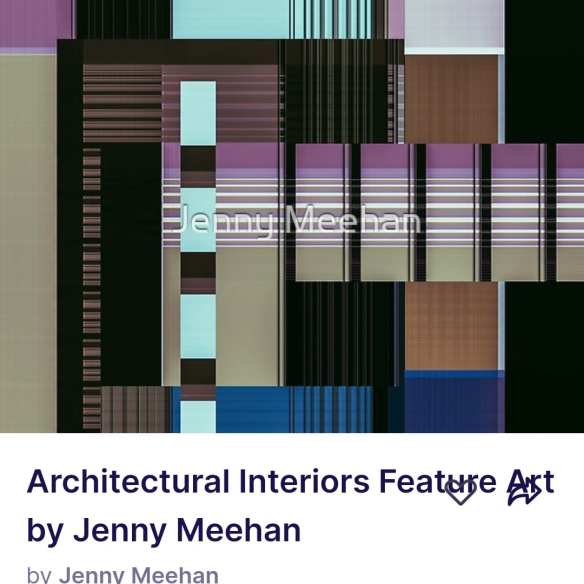
- Architectural Interiors Art Print by Jenny Meehan aka jennyjimjams
Platonic by Marisa G. Franco
I’ve just finished reading “Platonic -How Understanding Your Attachment Style Can Help You Make and Keep Friends” by Marisa G. Franco, PhD. I Love this book, and I’m so grateful that I’ve been able to read it!
It’s full of goodness… I learnt so much from it and found it touched on so many interesting areas. Here’s a snippet from it which I found linked in very well with previous my reading of “Ace: What Asexuality Reveals About Desire, Society, and the Meaning of Sex” by Angela Chen. Funnily enough, but not surprisingly, she references “Ace” by Angela Chen! Here’s a section I’ve been thinking about a lot:
“Another reason showing love for friends isn’t popular relative to doing so for romantic partners is because of the jumbling of any type of love with sexual love. We are petrified to express love for our friends, because if we do we risk accusations of being attracted to them.
But this muddling reveals our collective confusion as to different forms of love. Angela Chen reveals in her book, “Ace” what asexuality reveals about desire, society and the meaning of sex” that we feel platonic love, like appreciation and liking towards someone, romantic love; heady passion and idealisation of someone, or sexual love; a desire to have sex with someone, – separately. We can feel passionate about someone; romantic love, without wanting to have sex with them; sexual love. This means that we can feel romance in the confines of friendship. There’s even a term for it: Romantic friendship”.
Its very refreshing to read this. I have sometimes experienced the way that a degree of romantic feelings and friendship go together, and to accept this, and let this simply be as a quality and aspect of a friendship is both helpful and liberating. Our society forces categories onto us, and labels onto everything, yet in reality, life is all complexity. There’s a richness and beauty in having the freedom to experience affection (and even a touch of adoration), in our friendships.
I think that, maybe to have an understanding in our heads of the difference between attachment (bonding) and choosing to love someone in a way which is not primarily based on meeting our own needs, is helpful. I’m not suggesting needs are not important, but balancing needs in relationships is a joint endeavour, and this is the case whatever the type of relationship in question.
Another thought I’ve had on this, is that to recognise a small degree of transient infatuation, (not limerence, which is a different thing) for what it is, rather than loading it with more significance than it deserves, can be wise. To romantically objectify someone is not love, because real love is based on knowing and accepting a person for who they really are; it’s a less one dimensional experience. Fantasy is fantasy and reality is reality. The two can get blurred, but at some point they naturally become clearer.
With time, and choice, relationships often mature platonically anyway, however they start off, and can become intimate in deep multifaceted ways. There are many forms of intimacy and ways to express affection and love towards people. Platonic love is not less than Sexual love. In fact I reckon there’s some good ground to say it’s more. But this may be my age and stage in life I guess!
I’ve had several conversations recently on this topic with friends who recall to me significant female to female attractions they had in the past, which were deep bonds, established through vulnerable friendships of significant importance. Highly valuable attachments, which were cherished. For some of us this can blend in harmoniously with sexual love as well, and with others not, or less so, but whatever we conceive as our sexual identity or experience as our sexual orientation, (this itself is not set in stone) it’s the quality of the relationship itself which matters, along with the mutual integrity and level of communication.
Maybe it’s because infatuation and sexual desire often go together, we assume they are inseparable? My feeling is that the wider context of connection, mutuality, and compassionate, respectful love, is more important.
Whatever our individual perspective, the wider context is something we all need to work on, and learn to patiently become more open to each other and to become better at appreciating others differences and different perspectives, rather than become threatened or defensive about diversity.
Oh, back to the book. I’ve been carried away by my own train of thought! As I often do!
She continues ( I’ve selected sections of text);
A bit more here:
“Romantic love and friendship isn’t radical. It’s traditional, if you peek back far enough into our history. Even now, it is normal for close friends, to feel the heavy passion and idealisation that we typically deem appropriate only for spouses. Nearly all the best friends I’ve interviewed and read about have appeared to share some degree of romantic love as I’ve defined it. They are excited about and territorial of each other, idealise each other, or want to spend all their time together. When we pretend romantic love is abnormal in friendship. We leave people ashamed and confused by the deep love they feel for friends. Then, instead of expressing this love, they bury it.”
Last, but not least…
“Romantic attraction can crop up without sexual attraction. And just because we feel one doesn’t mean we feel the other. What happened? Why are we so much less comfortable now sharing this depth of love with our friends? Our discomfort with affection in friendships, coincides with the rise of homophobia, as it is expressed today. Before the 1900s sexual behaviours didn’t comprise an aspect of one’s identity, like they do today. Before 1868 There was no “Straight” or “gay” according to Hanne Blank author of “Straight: The Surprisingly Short History of Heterosexuality” because sexual orientation wasn’t an identity. People were harshly stigmatised for having sex with someone of their gender, but not for being or even seeming gay.”
In the theme of this reading I also found this excellent and interesting article by Brandon Ambrosino :
https://www.bbc.com/future/article/20170315-the-invention-of-heterosexuality
which references some of the same reading. (Brandon Ambrosino has written for the New York Times, Boston Globe, The Atlantic, Politico, Economist, and other publications. He lives in Delaware, and is a graduate student in theology at Villanova University).
Its worth adding, he’s not saying (to my understanding) that embracing a concept of a distinct sexual identity for oneself, ie, lesbian, bisexual or homosexual, etc. is a bad thing, or doesn’t have a place, nor is he saying that recognising your sexual orientation can’t be helpful, rather he’s opening up a wider recognition of fluidity in sexual identities and orientations, and opening up a discourse on the way that language and cultural changes through history can be taken into consideration when we think about differences in our sexuality. It’s important to respect that how important a defined sexual identity is to a person is going to vary a lot; this too is an area of diversity with no “right” or “wrong” approach.
Sexuality is one, very important, facet of identity but it is not a person’s identity in its totality; We are more complex than this. Historical models of sexual identity have tended to view its formation as a process undergone only by sexual minorities, while more contemporary models view the process as far more universal and attempt to present sexual identity within the larger scope of other major identity theories and processes.
My opinion is that recognising this can be helpful to many people, because identity is very complex rich and varied, with the sexual being just one aspect. Both heterosexual behavior and homosexual behavior are normal aspects of human sexuality. Lesbian, gay, and bisexual orientations, (plus the many variations we are now more aware of such as asexuality), are simply differences which we all benefit from accepting and respecting.
Well, that was an interesting stream of thought!
Winter Song by Anna Tabbush
Beautiful. I’ve been meditating on this song, and its making me cry rather a lot, but that’s all good! I have icy parts of my life and heart which need melting, and this song seems to be doing the job well!
“Winter Song”, below is a version sung by “The Wilderness Yet”
Winter Song by Anna Tabbush
When all life has left the ground
When ice like diamond sparkles around
When Jack Frost creeps under your skin
Cold winds blow out the fire within
When the swallow takes her flight
When the day is filled with night
Light a flame to guide you through
Spring will surely come to you
Darkness fills the icy gloom
Still and silent as a tomb
When the heart is heavy with woe
Fill up this room with an earthly glow
Strike a flame and touch a hand
For that is the gift of man
Light the love to guide you through
Spring will surely come to you. “
Thanks to Anna Tabbush for permission to publish the words of her poem here. Check out her work here:
Winter Song was written by Anna Tabbush, and there is another beautiful rendition of it here:
My favourite lines…
Cold winds blow out the fire within
When the day is filled with night
Light the love to guide you through
Spring will surely come to you
There is no way I can’t post up my digital image “Spring Will Come”… Its not new, one of my early ones, but the emotion behind it when it was created matches the song, so it’s reminded me of it!
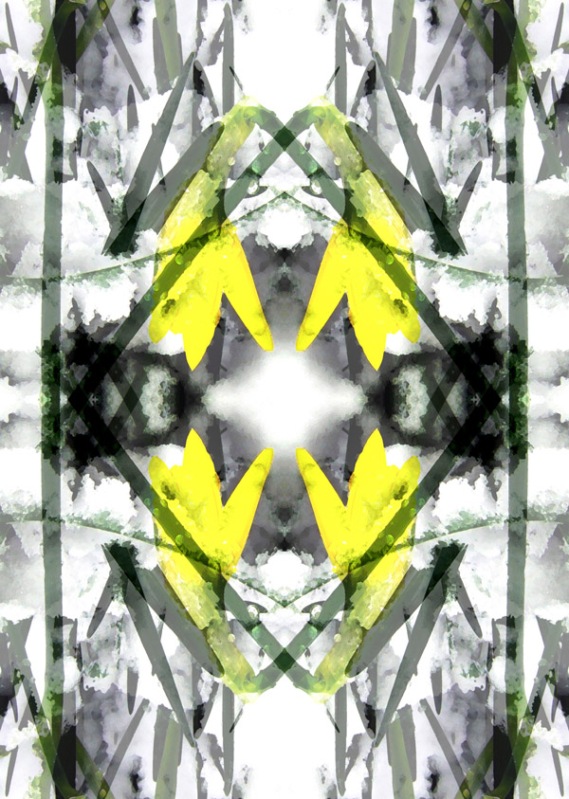
spring will come digital image jenny meehan ©jenny meehan
I created “Spring will Come” in 2008 when I was facing some hard situations, so the sight of some daffodils in the garden in the snow was an image I was motivated to experiment with digitally. Coldness, icy-ness, frozen water, glass, in my work act as a metaphor for the “freeze” state: very much an inability to move or to feel emotionally.
Ida Applebroog
![The Mother & The Weaver Marginalia (Baby with Weight), 1992 Ida Applebroog (b.1929) Oil and resin on canvas '[The subject of my work is] how power works - male over female, parents over children, governments over people, doctors over patients.' This disturbing image depicts a baby, physically bound and weighted, which makes symbolic reference to an abuse of power. Viewed from behind, the angle emphasises the child's vulnerability. The detail of the weight might suggest the presence of an emotional burden, or it could have more sinister connotations. This painting is from an extended and open-ended series called Marginalias (or 'notes in the margin'), though each painting is a stand-alone work. Applebroog embraces the new meanings that changes of contexts provide.](https://jennymeehan.files.wordpress.com/2023/11/img_20231115_151103_copy_600x800.jpg?w=584)
Came across this interesting work at the Foundling Museum! Here’s the text which was with it…
“The Mother & The Weaver Marginalia (Baby with Weight), 1992 Ida Applebroog (b.1929) Oil and resin on canvas ‘[The subject of my work is] how power works – male over female, parents over children, governments over people, doctors over patients.’
This image of a baby, physically bound and weighted makes symbolic reference to an abuse of power. The weight may suggest the presence of an emotional burden, or “it could have more sinister connotations” the text presented with it goes. I’m thinking about putting a weight on something you throw in water to make it sink… Maybe that is what they meant by that?
The painting is from an open-ended series called Marginalias (or ‘notes in the margin’), though each painting is also a stand-alone work.
Born Ida Appelbaum, Ida Applebroog was a multi-faceted artist, known for her paintings and sculptures dwelling on gender, sexual identity, and power dynamics. Her journey began with graphic design and freelancing, then developed into an exploration of societal norms.
A period of self-discovery in the late 1960s led to her iconic “bathtub sketches,” laying the foundation for her feminist-centric artistry.
Returning to New York in 1974, she embraced her new identity, Ida Applebroog, diving deeper into the societal and political discourse through her art. A series of self-published books, exhibitions, and an active part in feminist art collectives marked this period. Her work found homes in revered institutions like the Museum of Modern Art and Guggenheim Museum, solidifying her stance in the art community.
Applebroog spent the past half-century conducting a sustained enquiry into human relations. At once beguiling and disturbing, her work explores themes of violence and power, gender politics, women’s sexuality, and domestic space.
Here’s some snippets of her spoken expression;
‘I’ve been practising art for so many years, more than I can tell you right now. It’s always been the same. The point is that I always have things going on in my head. There’s a lot of note taking. Sometimes it goes wrong, but out of that comes something else, and like a snowball it just keeps gaining momentum. And time goes on until finally one piece informs the other piece, and you end up with a body of work,’
“It’s hard to say what is your work about. But for me it’s really how power works,”
“Male over female, parents over children, governments over people, doctors over patients.”
“I don’t consider myself a sculptor or a painter or a book artist or a conceptual artist. I just make art”.
“No matter what I see, no matter what I do, it all feeds me.
Anybody that creates, they’re going to find a way to create. It doesn’t matter how.”
Ida Applebroog died on October 22, 2023
The Mother & The Weaver
Here’s a quote from the Foundling Museum website:
“‘The Spider is an ode to my mother. She was my best friend. Like a spider, my mother was a weaver.’ – Louise Bourgeois, 2001
This landmark exhibition presents an opportunity to explore the Museum’s historic collection in a new light.
The Mother & The Weaver takes the unseen mother, a central part of the Foundling Museum’s story, as a point of departure to explore complex ideas around motherhood, childhood, love, loss, sexuality and identity. Occupying the whole museum, this landmark exhibition shows over 40 works from the Ursula Hauser Collection, all by women artists, in conversation with historic objects and works of art from the Foundling Museum’s collection.
The exhibition presents modern and contemporary works of art in a variety of media, including painting, textiles, sculpture, video and works on paper. The internationally celebrated artists on display include Louise Bourgeois, Marlene Dumas, Luchita Hurtado, Maria Lassnig, Sonia Gomes and Pipilotti Rist.
Maternal presence or absence, and the complex emotions that each arouses, informs many of the works in the exhibition. Others are more suggestive, hinting at complex histories of displacement and fractured identity. Themes and ideas around what it means to be a ‘good’ mother or woman, explored in the contemporary works, take on new and forceful meanings in the context of the Foundling Museum.
By presenting these works in juxtaposition with the Museum’s collection, visitors are invited to explore our stories with fresh eyes.
Ursula Hauser has been building her collection of modern and contemporary art since the 1980s. She selects artworks that captivate and move her, and places a special emphasis on female artists.
Supported by Taylor Wessing and The 1739 Club.”

Foundling Museum in London
Belly Cushion 1968 Alina Szapocznikow
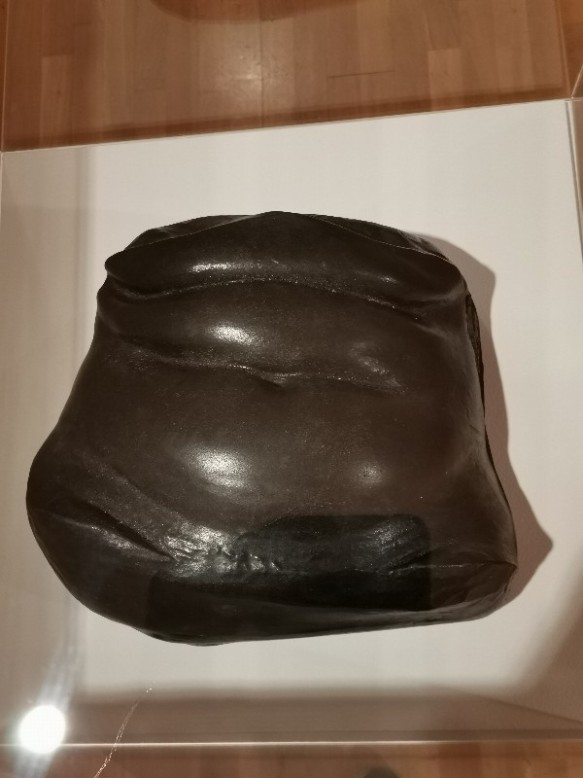
” Brzuch-poduszka / Ventre-coussi (Belly Cushion), 1968 Alina Szapocznikow (1926-1973) Mousse polyurethane
As I grapple with my own feelings about my own belly, this piece held a special place for me during my visit! The text provided was as follows:
‘I am convinced that of all the manifestations of the ephemeral, the human body is the most vulnerable, the only source of all joy, all suffering, and all truth.’
Polish artist Szapocznikow here focuses on the belly, often perceived as the source of human life through pregnancy. These cushions were based on casts the artist made of a friend’s stomach. They were intended for mass production but were never produced at scale. Szapocznikow survived the Holocaust in the concentration camps of Auschwitz and Bergen-Belsen. She rarely spoke of her traumatic experiences, instead choosing to process them through her art.”
Quoted from exhibition display
Spider V, 1999 Louise Bourgeois
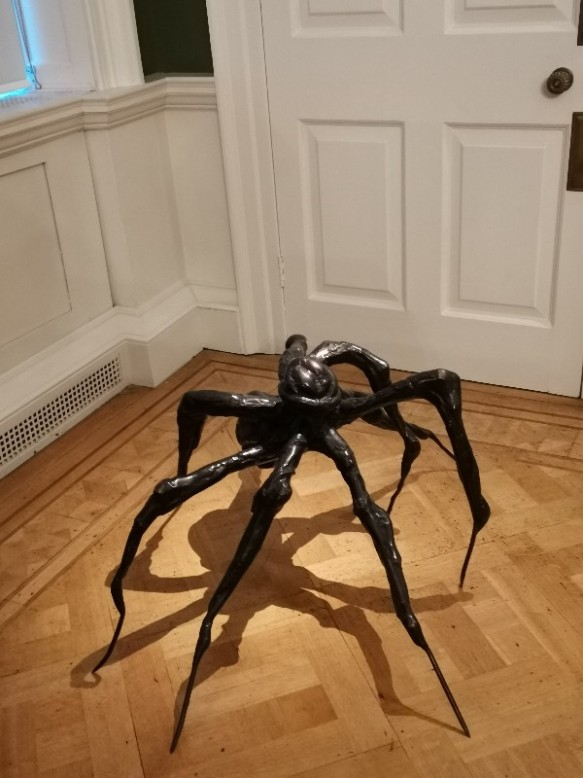
The Mother & The Weaver
“Spider V, 1999 Louise Bourgeois (1911-2010) Bronze Ed. 4/6 + 1 AP
‘I came from a family of repairers. The spider is a repairer. If you bash into the web of a spider, she doesn’t get mad. She weaves and she repairs it.’
The spider is one of the most recognisable motifs in Bourgeois’s work. These spiders refer to her own mother who was a weaver and worked in the family’s tapestry restoration business. As spiders ‘weave’ thread from their own bodies, they are also a symbol of female creativity.”
Quoted from exhibition display
I’ll post some more from this visit in later posts!
She was Fragile like a Bomb
Over the Winter months I tend to graduate towards digital media and writing, so though I’m posting a lot of my paintings this month I will also share some recent digital work with you.
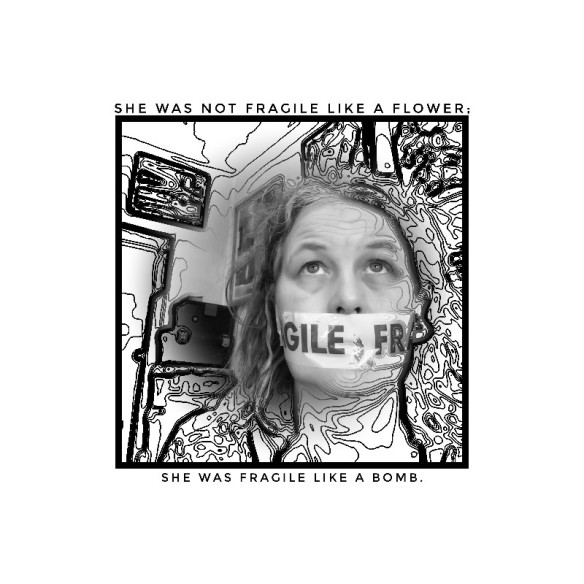
She was fragile like a bomb by Jenny Meehan
I ask myself how to embrace and channel anger into passionate action, purpose, and insight, rather than to let anger become rage, which is destructive.
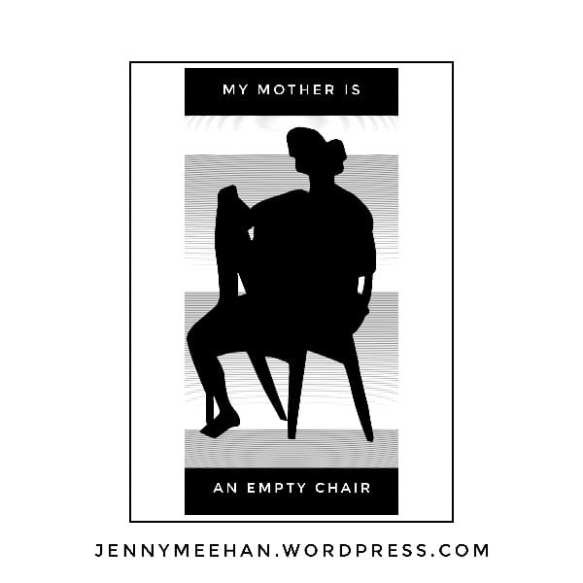
My Mother is an Empty chair ©jenny meehan
I ask myself how my mother’s absence, both psychological/emotional and physical, has impressed upon me and the way a loss presence may lessen my inner sense of stability and security.
Unravelling a Wire Nest
I created two short videos for the “16 days of activism against violence” which runs from 25th November to 10th December each year. “Unravelling a Wire Nest” is a poem I wrote over the 16 days of activism against violence period. I’ve been working on the initial draft and I’ve settled in this video poem as the end result:
The video poem I’ve titled “Love Needs No Power – Unravelling a Wire Nest”
There is also “Wire Nest without Words”
https://youtu.be/QYAo4PRyt68?feature=shared.
I think I’ll probably work into that again at some point.
In the subject of poetry, I found a poem recently and love it to bits! I’ll be taking more of a look at Sharon Owens work for sure! It’s called Dangerous Coats by Sharon Owens. I won’t quote it all because I haven’t sought permission, but here’s a fragment:
“So ladies, start sewing
Dangerous coats
Made of pockets & sedition”
Sharon Owens is a writer and painter based in Belfast, Northern Ireland. She graduated from the Belfast School of Art with a degree in Illustration in 1992 and began writing Women’s Fiction in 2002.
Here’s a link:
Below are a few random sections from some of my paintings to (nearly) finish off with!
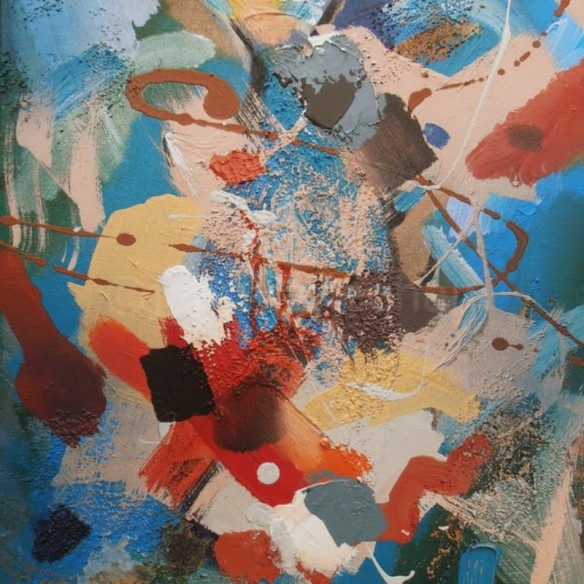
Section of Abstract painting by contemporary painter poet jenny meehan aka jennyjimjams ©jenny meehan Lyrical Abstraction London artist in art journal
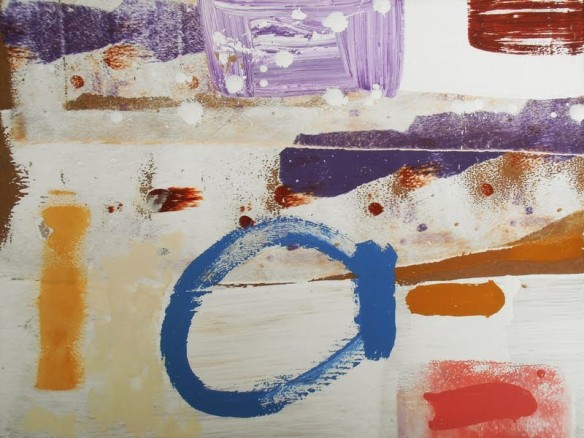
Abstract painting by contemporary painter poet jenny meehan aka jennyjimjams ©jenny meehan Lyrical Abstraction London artist in art journal
It’s been some time since I painted, but I look back on my previous paintings and it kind of feeds my mind, it’s almost like I’m going through the process of painting them again. I still feel I’m learning from them. It’s rather like looking at an experiment or exploration you made and rediscovering things all over again. I do believe contemplation is powerful.
Women Catholic Bishops
Though I am not part of the Catholic Church, it does represent a large section of the the Christian faith population, and my past participation in various retreat days and courses run by the London Jesuit Centre in London became my introduction to some aspects of Catholic perspectives and tradition. All very very good for me, as past experience was very Protestant, and, as with everything, biased in its own way.
So it was good to open myself up to some of the beautiful facets of the tradition, and a blessing indeed. It makes me sad though that there are so many women in the church held back, restricted, and limited in areas of ministry. There are moves to change this. It’s less than the best, in my view.
How lovely it is that rivers burst their banks sometimes, and women move forwards anyway, in faith, love and hope. An example is this is
The Association of Roman Catholic Women Priests (ARCWP). It is part of the world-wide Roman Catholic Women Priests movement. This traces its origin to the ordination of seven women to the priesthood by a male Roman Catholic bishop on June 29, 2002.
The ordinations took place at Passau in southeastern Germany, on the Danube River, and the “Danube 7” became the first priests of the movement. In 2003 two of the Danube 7 were ordained bishops, with a third woman from the group receiving episcopal ordination in 2005. Additional ordinations of deacons, priests, and bishops followed throughout the world.
Not surprisingly, The Roman Catholic Church has denied the validity of any ordination in the movement, and it has excommunicated women who have received ordination. This is sad, tragic, and strange, because
The Women Priests movement affirmed the validity of its ordinations, claiming that the Roman Catholic male bishop who ordained the first woman bishop was a bishop with apostolic succession within the Roman Catholic Church in communion with the pope.
I’m not really into the apostolic succession stuff, but they do have a very logical point in keeping with their tradition.
In the wake of the ordination of twelve women in Pittsburgh in 2006 there emerged a new group called Roman Catholic Women Priests (RCWP)–North America. This group divided in early 2007 into a separate Canadian organization and one called RCWP-USA. ARCWP began as the Southern Region of RCWP-USA. In 2010 members of this southern regional group, led by Bishop Brigid Mary Meehan and priests Janice Sevre-Dusynska and Judy Lee, broke away from RCWP-USA to form the Association of Roman Catholic Women Priests. Their differences of opinion with RCWP-USA over decision-making and social activism precipitated the break. ARCWP dates its origin as a separate organization within the world-wide Women Priests movement to October 21, 2010.
Since 2010 ARCWP established its own governing structure, and carried out the ordinations of many deacons, priests, and bishops who have gone on to pursue a variety of ministries. The ARCWP is an intentionally non-hierarchical organization that aspires to a consensus model of governance.
So, from a small beginning, such a lot can grow. I can see how this would be viewed as something that the more conservative in the Catholic Church would not want to grow. But grow it does, and grow it will, and where the Holy Spirit is, there is life, growth, faith, and women. Women free to move in authority, in equal authority, in Love and service.
According to its Mission Statement: “The Association of Roman Catholic women priests, therefore, responds to this call from the Holy Spirit, in our time, by preparing, ordaining and supporting qualified women and men, from all states of life, who are committed to a model of Church grounded in Jesus’ vision of an open table, where all are welcome. By our living and ministering within a community of equals, we are respectful of differences among people. In the tradition of our mystics and prophets, we challenge the dominance of patriarchal systems by promoting practices of equality that lead us to recognize and stand for justice on behalf of all people, locally and globally, and on behalf of the urgent needs of Eco-justice for our planet.”
Ah, there is hope and more. Onwards and upwards. Progress is natural. Change is vital. Life is love, and” a community of equals” is common sense, commonality, Communion in the most Christian sense.
Well, that’s me for now. Godde bless!
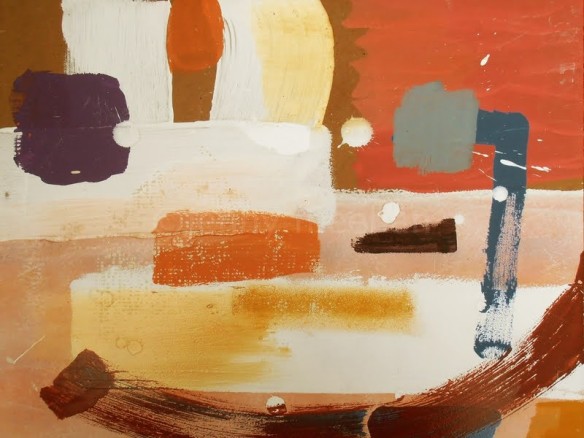
“Harbour Painting” Abstract painting by contemporary painter poet jenny meehan aka jennyjimjams ©jenny meehan Lyrical Abstraction London artist in art journal
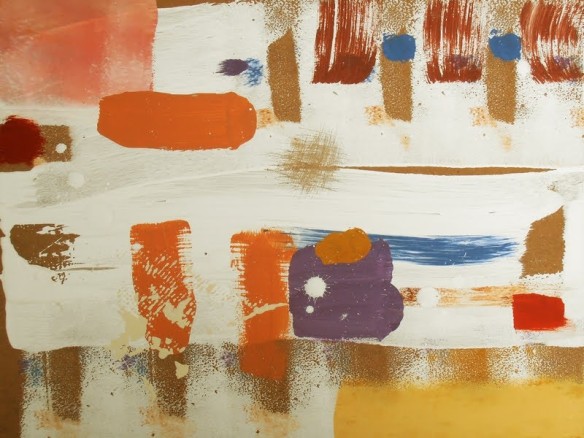
River Journey Abstract painting by contemporary painter poet jenny meehan aka jennyjimjams ©jenny meehan Lyrical Abstraction London artist in art journal
Image Licensing – Jenny Meehan
My image copyright is managed through DACS. Because they naturally propose the industry standard fees, this can be rather prohibitive for many smaller organisations and individuals seeking to use my images.
However, a big plus is…
They ensure that all paperwork and details are thoroughly and legally dealt with, including keeping their own records. All of this protects both parties ensuring a clear, error free administration.
They can also inform, advise, and generally help you as need be with the process.
Contact me directly with your image licensing request and I’ll outline the process for you.
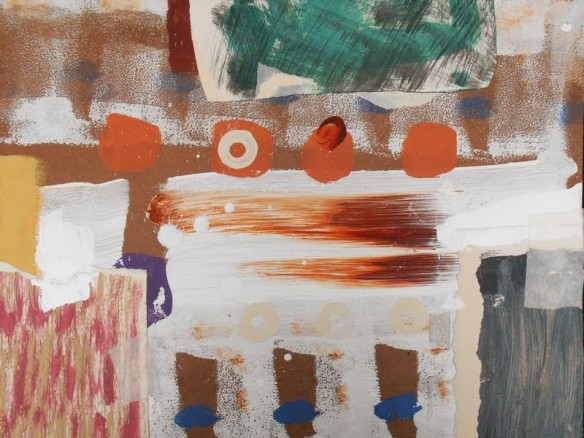
Mending Abstract painting by contemporary painter poet jenny meehan aka jennyjimjams ©jenny meehan Lyrical Abstraction London artist in art journal
Contact Jenny Meehan UK Artist Designer
I’m trying to remember to insert contact forms regularly in my blog posts! Do follow me on WordPress!
